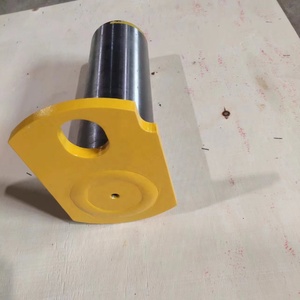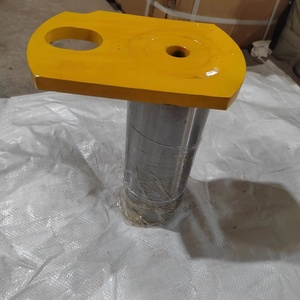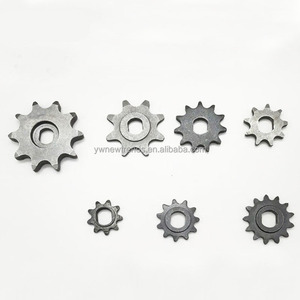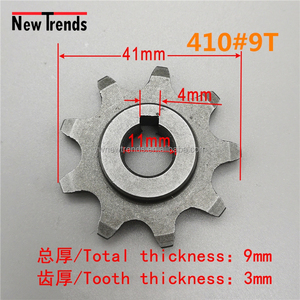
All categories
Featured selections
Trade Assurance
Buyer Central
Help Center
Get the app
Become a supplier

(904 products available)






































420 and 428 blank sprockets are essentially components used in the development of chains and sprocket systems. They have different applications depending on certain parameters. Here are the common types of blank sprockets that exist:
Steel sprockets are popular and commonly used in industries. People consider them durable and resilient for challenging workloads. Moreover, they come with operational longevity. It is also worth noting that these sprockets are often treated to prevent rust or corrosion.
If a lightweight yet sturdy material is desired, then blank sprockets made from aluminum should be considered. These are mainly applicable in areas where reduction in weight is a necessity. Some of these places include bicycles or small machinery. The metal is extremely resistant to rusting as well, so it is very secure for outdoor applications.
A CNC (Computer Numerical Control) process is an effective way of creating a 420 chain sprocket or an 428 chain sprocket under unique specifications. This method provides high accuracy, low wastage, and the ability to create complex designs. However, this will require a lot of investment in creating the prototype and setting up the machinery.
Custom-made sprockets are designed specifically to cater to unique operational requirements. It can be either for particular machinery or for certain working conditions. These sprockets usually entail a better use of resources. This is because they ensure maximum efficiency and compatibility of the system.
Brass is a non-ferrous alloy metal. Blank sprockets made from brass are mainly used in applications for small machinery. Also, they are applicable in environments where resistance to corrosion is crucial. Though not as common for heavy industrial use, they still provide effective performance in low-load applications.
A business has to consider several factors to ensure that its customers are satisfied with their purchases. Here are the key parameters to focus on when selecting the sprockets:
The material that a sprocket is made from has an impact on its durability and performance capability. Common materials include steel alloys, aluminum, and even brass in some cases, as well as other players. Customers will often go for what will last longer while giving them value for money.
The size of the sprocket directly affects the compatibility with the chain. A mismatch in size will create more problems than the system facing low-load applications. The businesses that stock these items might not always have the luxury of selecting the items’ sizes for various reasons.
Load capacity is a highly important factor for any business dealing in machinery products. The blank sprocket's load capacity should be consistent with the operating conditions and the compatibility of the system components.
The manufacturing process usually denotes the quality of the final product. This also affects its cost. Conventional cast or forged sprockets tend to have lower prices in the market. However, CNC machined sprockets provide superior accuracy and performance. Moreover, they come with a higher price attached as well.
The intended application is yet another key factor in choosing the right sprocket. Blank sprockets intended for bicycles or light machinery are likely to differ in design from those meant for industrial use. It is important to understand the customer’s needs in advance.
A sprocket's key features determine its utility and effectiveness in any chain system it is used in. Here are some of the key characteristics of a 420 chain or 428 chain sprocket:
The tooth design on a sprocket is equally vital to the performance and efficiency of power transmission systems. Sharp teeth with proper spacing help in smooth engagement with the chain. This ensures maximum contact without friction arising between the components. Such a characteristic prevents wear and tear on the system.
The sprocket hub holds the teeth and is the central segment of the sprocket. Its design should be compatible with the equipment in the system. An improper hub fitting can lead to misalignment issues. It can cause unnecessary wastage of power within the systems by impacting the chain.
Surface finish plays a role in the longevity of the sprocket. Finishes like hard anodizing or black oxide treatments provide the required protection against wear and corrosion. A well-finished surface also has less friction. Thus, it leads to an improvement in the operational efficiency of the system.
Most manufacturers of blank sprockets usually offer some types of customization. This could be in their sizes or even materials used to make them. Such adaptations are particularly useful to clients with unique needs. This, in turn, helps them use the available space or align with their specific technical requirements.
For businesses, branding blank sprockets is a possible source of extra income. It could be, for instance, engraving the company's logo on the sprocket. This would improve the visibility of the brand in the market. Further, it would enhance brand recognition among the customers. Therefore, a strong brand presence is essential in retail sectors.
It's necessary that, as a business owner, they understand how their customers will eventually handle their products. More importantly, they should understand the instructions to do it themselves and the replacement facilities. So, here is how to install and replace blank sprockets:
A business can outsource making sprockets to service providers with reasonable prices. One of the options to consider is creating the sprockets in-house with the help of welding jigs, fasteners, and a few other supplies. Aluminum or steel rods can be purchased to make the blanks. A manual lathe or an automated one can then be used to shape the sprocket teeth.
Common tools needed for replacing a blank sprocket include a wrenches set, chain breaker, pin punch set, a flathead screwdriver, torque wrench, and soft jaws vice.
Start by disconnecting the power source or taking off the battery. Then, remove the chain from the sprocket carefully using a chain breaker. Next, unscrew the bolts or the fasteners holding the sprocket to the hub. Finally, gently pull the sprocket off the shaft.
When the old sprocket is off the way, position the new one on the shaft. Ensure the sprocket's mounting holes are aligned with the shaft. Take the bolts or the fasteners for the sprocket and then screw them into place. Make sure they tightened firmly using torque standards. Go ahead and reattach the chain around the sprocket. Then reconnect the power source.
Understanding the following usage circumstances for different sprockets helps businesses stock the much-needed items. They also provide a solid foundation for advising clients. Here are some common applications:
People use 420 and 428 sprockets in bicycles, motorcycles, and electric scooters, for instance. They help in power transmission between the pedal or motor and the wheels. A bigger or smaller sprocket can thus be fitted to cater to speed or torque requirements, respectively.
These sprockets are also widely used in manufacturing equipment. This is especially for chains and gear systems in conveyor belts, rollers, and other machines. These blank sprockets facilitate the moving of products and components in production lines. Their durability makes them ideal for industrial applications where there are moderate to heavy loads.
420 and 428 sprockets are common in power equipment like chainsaws, leaf blowers, and small engines. They help in the transfer of power from the motor to other moving components. These blank sprockets can easily be changed to meet the desired performance needs in the equipment.
Boat propulsion systems also have these sprockets, which work with chains to drive the propeller. The selection of the appropriate sprocket size directly influences the efficiency of possible speed and fuel consumption.
Examples of commercial vehicles include trucks and heavy machinery within the earth-moving and construction sectors. In these vehicles, both the 420 and 428 sprockets work with roller chains in track drives or shoes. Such applications normally involve heavier loads and require more robust and bigger-sized sprockets.
The difference between the two is in their sizes. Thus, the decision will simply depend on the market demand and the compatibility of the industry with the products. One may be preferred over the other based on various usage circumstances, equipment, and customer requirements.
Businesses use both types of sprockets in the machinery and manufacturing, automotive, agricultural, and even marine industries. As mentioned earlier, they are used to transfer power, which is a basic requirement of most industries.
Help customers with their preferences, the options available, and the industries they serve. After that, focus on two major aspects: quality and pricing. More importantly, set up a simple and efficient online ordering system so customers can place orders easily. This would be combined with providing excellent customer care services and a product warranty.
To begin with, regular cleaning and maintenance are key. It will remove dirt, grease, and debris. The second thing is using the correct type of lubricant for the specific applications and lubricating frequently. Another point to consider is periodic inspections and replacements of a chain when worn out.
A business should be guided by the equipment or vehicle's manufacturer. Moreso, both the 420 and 428 chain and sprocket kits are readily available in different industries. They may also offer some customization options to cater to specific needs. The key is understanding the client's needs and making a well-informed decision.